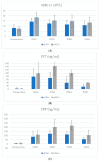Correlation of Different Serum Biomarkers with Prediction of Early Pancreatic Graft Dysfunction Following Simultaneous Pancreas and Kidney Transplantation
- PMID: 35566689
- PMCID: PMC9103915
- DOI: 10.3390/jcm11092563
Correlation of Different Serum Biomarkers with Prediction of Early Pancreatic Graft Dysfunction Following Simultaneous Pancreas and Kidney Transplantation
Abstract
Background: Despite recent advances and refinements in perioperative management of simultaneous pancreas−kidney transplantation (SPKT) early pancreatic graft dysfunction (ePGD) remains a critical problem with serious impairment of early and long-term graft function and outcome. Hence, we evaluated a panel of classical blood serum markers for their value in predicting early graft dysfunction in patients undergoing SPKT. Methods: From a prospectively collected database medical data of 105 patients undergoing SPKT between 1998 and 2018 at our center were retrospectively analyzed. The primary study outcome was the detection of occurrence of early pancreatic graft dysfunction (ePGD), the secondary study outcome was early renal graft dysfunction (eRGD) as well as all other outcome parameters associated with the graft function. In this context, ePGD was defined as pancreas graft-related complications including graft pancreatitis, pancreatic abscess/peritonitis, delayed graft function, graft thrombosis, bleeding, rejection and the consecutive need for re-laparotomy due to graft-related complications within 3 months. With regard to analyzing ePGD, serum levels of white blood cell count (WBC), C-reactive protein (CRP), procalcitonin (PCT), pancreatic lipase as well as neutrophil−lymphocyte ratio (NLR) and platelet−lymphocyte ratio (PLR) were measured preoperatively and at postoperative days (POD) 1, 2, 3 and 5. Further, peak serum levels of CRP and lipase during the first 72 h were evaluated. Receiver operating characteristics (ROC) curves were performed to assess their predictive value for ePGD and eRGD. Cut-off levels were calculated with the Youden index. Significant diagnostic biochemical cut-offs as well as other prognostic clinical factors were tested in a multivariate logistic regression model. Results: Of the 105 patients included, 43 patients (41%) and 28 patients (27%) developed ePGD and eRGD following SPKT, respectively. The mean WBC, PCT, NLR, PLR, CRP and lipase levels were significantly higher on most PODs in the ePGD group compared to the non-ePGD group. ROC analysis indicated that peak lipase (AUC: 0.82) and peak CRP levels (AUC: 0.89) were highly predictive for ePGD after SPKT. The combination of both achieved the highest AUC (0.92; p < 0.01) in predicting ePGD. Concerning eRGD, predictive accuracy of all analyzed serological markers was moderate (all AUC < 0.8). Additionally, multivariable analysis identified previous dialysis/no preemptive transplantation (OR 2.4 (95% CI: 1.41−4.01), p = 0.021), donor age (OR 1.07 (95% CI: 1.03−1.14), p < 0.010), donor body mass index (OR 1.32 (95% CI: 1.01−1.072), p = 0.04), donors cerebrovascular cause of death (OR 7.8 (95% CI: 2.21−26.9), p < 0.010), donor length of ICU stay (OR 1.27 (95% CI: 1.08−1.49), p < 0.010), as well as CIT pancreas (OR 1.07 (95% CI: 1.03−1.14), p < 0.010) as clinical relevant prognostic predictors for ePGD. Further, a peak of lipase (OR 1.04 (95% CI: 1.02−1.07), p < 0.010), peak of CRP levels (OR 1.12 (95% CI: 1.02−1.23), p < 0.010), pancreatic serum lipase concentration on POD 2 > 150 IU/L (OR 2.9 (95% CI: 1.2−7.13), p = 0.021) and CRP levels of ≥ 180 ng/mL on POD 2 (OR 3.6 (95% CI: 1.54−8.34), p < 0.01) and CRP levels > 150 ng/mL on POD 3 (OR 4.5 (95% CI: 1.7−11.4), p < 0.01) were revealed as independent biochemical predictive variables for ePGD after transplantation. Conclusions: In the current study, the combination of peak lipase and CRP levels were highly effective in predicting early pancreatic graft dysfunction development following SPKT. In contrast, for early renal graft dysfunction the predictive value of this parameter was less sensitive. Intensified monitoring of these parameters may be helpful for identifying patients at a higher risk of pancreatic ischemia reperfusion injury and various IRI- associated postoperative complications leading to ePGD and thus deteriorated outcome.
Keywords: C-reactive protein; biomarker; early pancreatic graft dysfunction; early renal graft dysfunction; graft function; graft outcome; ischemia reperfusion injury; lipase; procalcitonin; simultaneous pancreas–kidney transplantation.
Conflict of interest statement
The authors declare no conflict of interest.
Figures




Similar articles
-
The Role of Innate Immune Cells in the Prediction of Early Renal Allograft Injury Following Kidney Transplantation.J Clin Med. 2022 Oct 18;11(20):6148. doi: 10.3390/jcm11206148. J Clin Med. 2022. PMID: 36294469 Free PMC article.
-
Analysis of Volatile Anesthetic-Induced Organ Protection in Simultaneous Pancreas-Kidney Transplantation.J Clin Med. 2022 Jun 13;11(12):3385. doi: 10.3390/jcm11123385. J Clin Med. 2022. PMID: 35743457 Free PMC article.
-
[Predictive value of procalcitonin in postoperative intra-abdominal infections after definitive operation of intestinal fistulae].Zhonghua Wei Chang Wai Ke Za Zhi. 2017 May 25;20(5):524-529. Zhonghua Wei Chang Wai Ke Za Zhi. 2017. PMID: 28534329 Chinese.
-
Diagnostic Accuracy of C-reactive Protein, Procalcitonin, White Blood Cell Count, and Neutrophil-Lymphocyte Ratio in the Early Detection of Post-surgical Infections: A Systematic Review.Cureus. 2025 Apr 7;17(4):e81853. doi: 10.7759/cureus.81853. eCollection 2025 Apr. Cureus. 2025. PMID: 40342430 Free PMC article. Review.
-
The Evaluation of Inflammatory Biomarkers in Predicting Progression of Acute Pancreatitis to Pancreatic Necrosis: A Diagnostic Test Accuracy Review.Healthcare (Basel). 2022 Dec 22;11(1):27. doi: 10.3390/healthcare11010027. Healthcare (Basel). 2022. PMID: 36611486 Free PMC article. Review.
Cited by
-
Does Timepoint of Surgical Procedure Affect the Outcome in Simultaneous Pancreas-Kidney Transplantation? A Retrospective Single-Center Analysis over 20 Years.J Clin Med. 2024 Jun 25;13(13):3688. doi: 10.3390/jcm13133688. J Clin Med. 2024. PMID: 38999254 Free PMC article.
References
-
- Benz S., Bergt S., Obermaier R., Wiessner R., Pfeffer F., Schareck W., Hopt U.T. Impairment of Microcirculation in the Early Reperfusion Period Predicts the Degree of Graft Pancreatitis in Clinical Pancreas Transplantation. Transplantation. 2001;71:759–763. doi: 10.1097/00007890-200103270-00012. - DOI - PubMed
LinkOut - more resources
Full Text Sources
Research Materials
Miscellaneous

